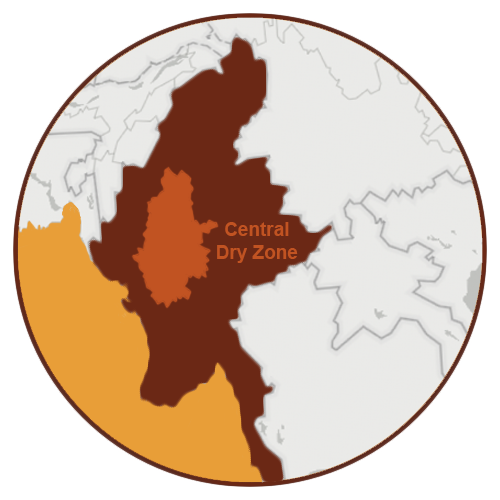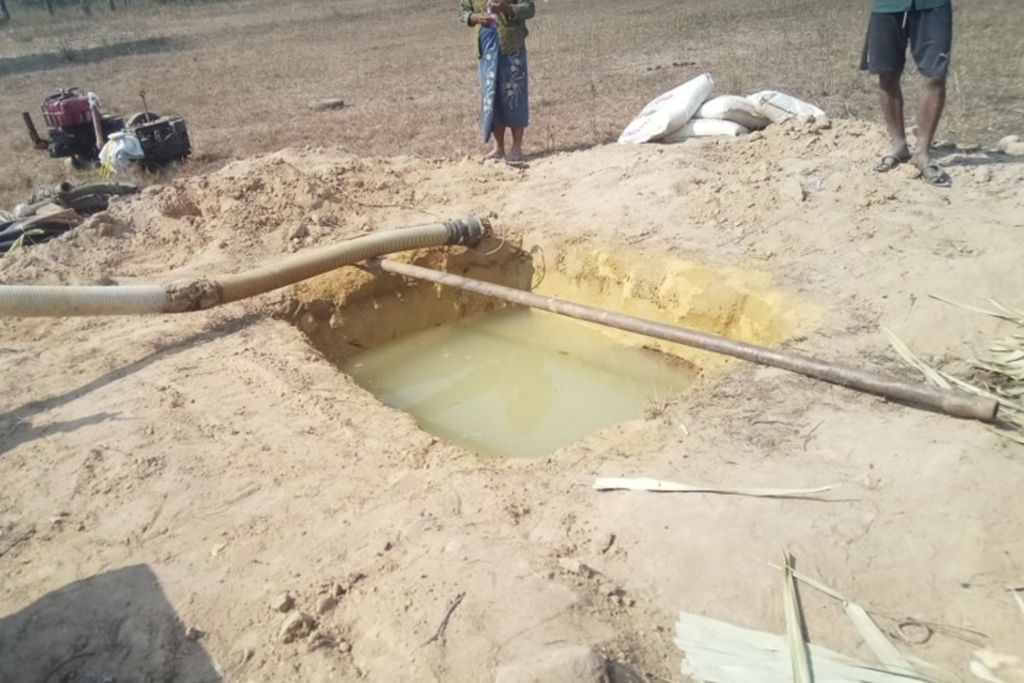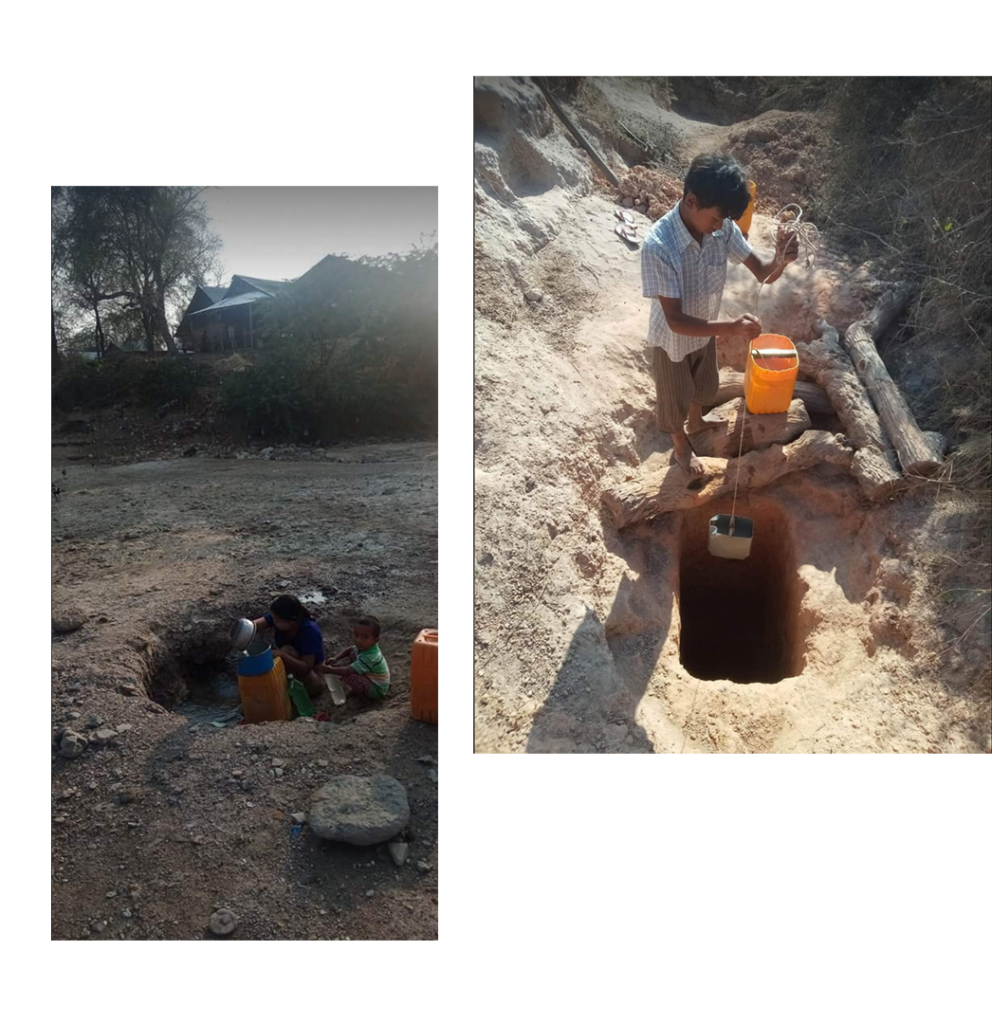LIVES LOST
FETCHING WATER IN MYANMAR
Women and girls risk their lives to fetch water in Myanmar’s Central Dry Zone, where fighting between the military and armed resistance groups blocks access to water.
By Poe Phyu Zin
PUBLISHED MAY 29, 2023
SAGAING, MYANMAR ― Daw Sein, 56, only thinks about running as fast as she can when she hears gunshots while on her way to fetch groundwater for her family in Myanmar’s Central Dry Zone. The scorching heat there has made water scarce.

The nearest spring is close to a military camp that houses soldiers tasked with attacking the armed people’s movement, which is fighting to restore democracy after the military coup in February 2021.
The resistance to military rule has led to a civil war across the country and resulted in attacks on civilians and their arrests.
Daw Sein is afraid of being caught on her way to get water. “I must take the risk because my family needs water,” she said
She will risk her life again the next time she fetches water, like the other women and girls in her community tasked with getting water for their households.
The inhabitants of Myanmar’s Central Dry Zone have always faced an everyday battle to get water in the extreme weather of their region, and the situation is getting worse.
The region is notorious for its scorching temperatures that can soar up to 43 degrees Celsius in the summer and drop to almost 10 Celsius in winter – arid conditions that make water scarce.

Accessing water sources has always been challenging for the 15.4 million people living in the Dry Zone.
The UNDP has reported that the residents of Sin Ka village in Magway Region’s Chauk Township have only one well that serves 700 people. They must walk for approximately 20 minutes to get the water.
Walking long distances on foot can leave women and girls at risk of being assaulted. They are also likely to miss school or job opportunities when they are tasked with long hours of household work.

This daily hardship became extremely dangerous after the coup, when the Myanmar military, known as the Tatmadaw, overthrew the civilian government and declared the general election held three months earlier to be invalid.

It ordered a bloody crackdown on democracy activists, anti-coup protesters and residents who took up arms to fight the junta – known as the People’s Defense Force (PDF). These civilian militia groups sprung up across the country after the coup.
Fighting broke out in many parts of the country, including in the Central Dry Zone.
Conflict blocks water access
Unlike other parts of Myanmar, which had experienced significant armed conflict since gaining independence from Great Britain in 1948, the Central Dry Zone had remained peaceful for several decades.
The area is home to the Bamar population, the country’s largest ethnic group constituting about 70% of the whole population. In the past, the military overlooked the area as the armed ethnic organizations did not have much of a presence there.
But after the coup, members of the resistance movement grew in number in the Central Dry Zone, like other parts of the country. This prompted the military to deploy more forces in the area, which covers 58 townships, partially in the Sagaing, Mandalay and Magway regions.
The military then launched brutal house raids and crackdowns on dissidents, which resulted in deaths and injuries to residents, including many who were not at the forefront of the resistance movement.
In August, local news reported that a 16-year-old girl and a 20-year-old woman were raped and killed by soldiers in Yinpaungtaing village in Yin Mar Bin Township in the Sagaing region. They had come from another town to shop in the village.
In a BBC interview with government soldiers, the troops admitted to raping, killing and torturing women and girls randomly when they attacked Yae Myet village in Sagaing as part of an operation to suppress anti-military groups.
They claimed they were ordered to “shoot anything you see”, including people not involved with the militias.

A dangerous trek
Despite her fear, 46-year-old mother of three Daw Mar Mar had no choice but to leave her house to get water from a well about a 40-minute walk away.
She had heard many stories of people being randomly attacked while walking to get water and recently, she too, experienced the brutality.
In January 2023, a group of soldiers raided Daw Mar Mar’s village in Sagaing’s Sar LinGyi town. She was cooking rice at that time.
She must abandon the house and run. She looked around and grabbed the most important things she could think of – water. It was essential to the survival of her and her family, she thought.
Daw Mar Mar left her house and hid in the bush with other villagers. The water she carried was not enough to feed her family as they hid, and they had to endure the heat and the thirst.
“This was the worst time ever in my life,” she recalled.
After the soldiers left, she returned to her village and found her house had been burned down. She and her family then had to move to a displaced person’s camp and watch out for soldiers whenever she left the camp to get water.
Local people reported that the military had destroyed wells and water tanks as part of their strategy to cut supplies to the People’s Defense Force. But destroying the wells also affected local communities that relied on those water sources.
Climate change being felt
In parallel to the conflict, climate change has caused extreme heat that has worsened the drought in the Central Dry Zone.
The monsoon season used to play a crucial role in regulating the amount of rain in the area, which received less than 750 millimeters annually, compared with the national average of 2,353 millimeters, according to a recent study.
However, now this system has been disturbed by changing weather patterns and temperatures, worsening the drought.
Another study pointed out that extreme temperature changes had been observed in the Central Dry Zone, with a 2.4-degree Celsius increase in the baseline temperature over the last 30 years. Incidents of water scarcity and droughts have also increased.
The area receives only 3.2% of the country’s total rainfall, while it accounts for 10% of the country’s total area.

In the bigger picture, Myanmar has always been prone to disasters – including droughts, flooding and cyclones – which have become worse due to extreme weather caused by climate change.
The Global Climate Risk Index ranked Myanmar the second among 180 countries most affected by extreme weather from 2000 to 2019, with 57 incidents recorded.
The impact of climate change was being felt by Daw Mar Mar, who has had to deal with fetching water every day, despite the risks. She found the water levels in some natural ponds had shrunk and some had gone entirely dry in the summer.
There was little water, even though local authorities had drilled many wells in recent years. This lack of water has forced her and other women to walk long distances to find water sources, running the risk of attacks and violence.
“It takes two hours for me to get water,” said Daw Thein, a resident in a village in Sagaing region, who recently hid in the jungle with her three children to avoid a battle between the military and the People’s Defense Force.
Because water is scarce, she must use her hands to dig the ground and wait about one hour for water to emerge. The water that emerges is not clean, but she and her family have no choice but to drink it.
“Life has become an immense struggle for us. Water scarcity is just one of the many challenges. Our village is regularly being raided and attacked by airstrikes and caught in cross-fires. Such incidents have become commonplace, and we are constantly living in fear,” she said.
“We know that running into soldiers while fetching water could result in our untimely death. But we have no other options. Without water, our survival is impossible.
We don’t need gold. Water is worth more than gold in our areas.”
Aid suspended
Myanmar’s civilian government and international aid organizations have initiated some climate-adaptation projects that aim to ensure water security in the Central Dry Zone.
Tu Hkawng, the Minister of Natural Resources and Environmental Conservation in the exiled Myanmar National Unity Government (NUG), said the ministry initially planned to develop a watershed area, build water tanks and water distribution pipes there.
But these projects were held back after the coup.

The ministry has very few staff who have remained within the country and worked in water conservation areas. The NUG’s volunteer staff, who are part of the anti-military Civil Disobedience Movement, must prioritize giving assistance to internally displaced people caused by the fighting between the military and armed resistance groups.
“Multiple factors, from limited human resources and funding to civil unrest, creates obstacles for the ministry and its staff to provide aid to people in the Central Dry Zone. We are looking for an alternative way to help the people there [handle the water shortage],” said Tu Hkawng.
Despite all the challenges, 28-year-old activist Ma Mie is raising funds from her network to drill wells in two villages in Bu Ta Lin district in Sagaing region, which hosts more than 320 internally displaced people.
“We managed to drill a well in a monastery located far from the battlefield. However, this is only a temporary solution for the affected community. Without more help, other areas [in the Central Dry Zone] will continue to suffer from severe water scarcity,” she said.
This story was supported by Internews’ Earth Journalism Network.





